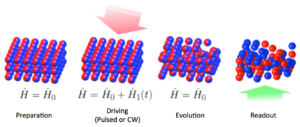 Improving our understanding of matter could lead to new technologies.
Improving our understanding of matter could lead to new technologies.
David Weld, assistant professor of physics at the University of California Santa Barbara, discusses how getting a solid out of equilibrium could bring us big benefits in the future.
David Weld received his bachelor’s degree in physics from Harvard University and his Ph.D. in physics from Stanford University. He worked as a postdoctoral researcher and research scientist at MIT before taking a job as an assistant professor of physics at UC Santa Barbara. He lives in Santa Barbara with his wife and three children.
The Dance of Atoms
The poet William Blake urged his readers to “see a world in a grain of sand.” How well do we actually understand what goes on inside a grain of sand? Well, sand is a solid. A big part of physics is the study of solids. We’ve known for a long time that solids are made up of atoms, bound together by a sea of electrons. Using quantum mechanics, we can understand solids in equilibrium pretty well. And this understanding is useful: the radio or computer you’re hearing this on is a direct technological result of the quantum theory of solids.

What’s not well understood is what happens when solids are out of equilibrium. As an example of a system out of equilibrium, imagine what happens when a rock is dropped in a calm pond. The formerly still and flat surface of the water is distorted into complex and fast-changing splashes and ripples. Similar splashes can occur in the electron sea inside a solid, but at much faster timescales, measured in billionths of billionths of a second.
Matter is hard to probe on these time scales, and even harder to understand. But improved understanding and control could lead to new technologies: ultrafast computers, cameras that can watch electrons move inside biomolecules, or even totally new devices based on exotic nonequilibrium states of matter.
Our research team is pursuing an unusual angle on the problem of understanding nonequilibrium matter. Instead of working on ordinary solids, we’re assembling a tiny chunk of synthetic matter, composed of strontium atoms held together by light instead of chemical bonds. This synthetic matter exists at much lower energy scales than ordinary matter, which means that it acts like a magnifying glass, but for magnifying time instead of space. This lets us observe the dynamics of our material far away from equilibrium in ultra-slow-motion. Using this approach, we hope to learn more about the behavior of nonequilibrium matter of all kinds. Blake might have called it an attempt to see the world in a grain of strontium.
Read More:

